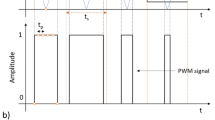Abstract
TIME modulation, where information is conveyed by changing the time between similar parts of the modulated wave-train rather than by the frequency of occurrence, has a feature which is of great importance at the demodulation stage. This can best be demonstrated by considering a common method of de-modulating a frequency-modulated wave-train and comparing it with a method which is particularly simple to use where the wave-train is time-modulated. Fig. 1 shows a frequency modulated wave-train with a step change in frequency; a common and representative method of de-modulation is shown in Fig. 2. The box represents a device which produces a pulse of current (di) of short and controlled duration for each pulse of the input wave-train. The mean current flowing through R is, therefore, n × di where n is the pulse-recurrence frequency. The mean potential across R is n × di × R and is proportional to the mean value of the pulse frequency and hence represents the original modulation waveform. The value of c does not affect the mean value of current but has a marked effect on the transient performance of the circuit. If it is assumed that the current pulse has a negligible duration compared with the repetition frequency, then the waveform across the capacitor will be as shown in Fig. 1. The fall in potential between pulses is represented by the expression ν = V (ε–t/cR) where ν is the capacitor potential at any time t after an input pulse at which time ν = V. The potential of the capacitor, therefore, falls exponentially with time with a time constant given by the product of c and R. In most situations it is desirable to recover the original modulating waveform undisturbed by components of the carrier, and the difficulty is to choose c.R so that the carrier frequency components (ripple) are at an acceptable level while maintaining a good transient performance of the de-modulated waveform. Often a simple resistance–capacitance filter will not give sufficiently good performance and elaborate low-pass filters must be used. The filters have, up to the present, always used inductive elements which are not as convenient to use as resistive–capacitance components (they must in general be specially wound) and cannot be made in ‘integrated circuit’ form. (This method of construction involves making the components and their interconnexions at the same time, often on a common surface.)
This is a preview of subscription content, access via your institution
Access options
Subscribe to this journal
Receive 51 print issues and online access
$199.00 per year
only $3.90 per issue
Buy this article
- Purchase on Springer Link
- Instant access to full article PDF
Prices may be subject to local taxes which are calculated during checkout
Similar content being viewed by others
References
de Sa, A., and Molyneux, L., World Med. Electron., 2, 174 (1964).
Author information
Authors and Affiliations
Rights and permissions
About this article
Cite this article
MOLYNEUX, L. Important Feature of Time Modulation. Nature 209, 188–190 (1966). https://doi.org/10.1038/209188a0
Issue Date:
DOI: https://doi.org/10.1038/209188a0
Comments
By submitting a comment you agree to abide by our Terms and Community Guidelines. If you find something abusive or that does not comply with our terms or guidelines please flag it as inappropriate.



